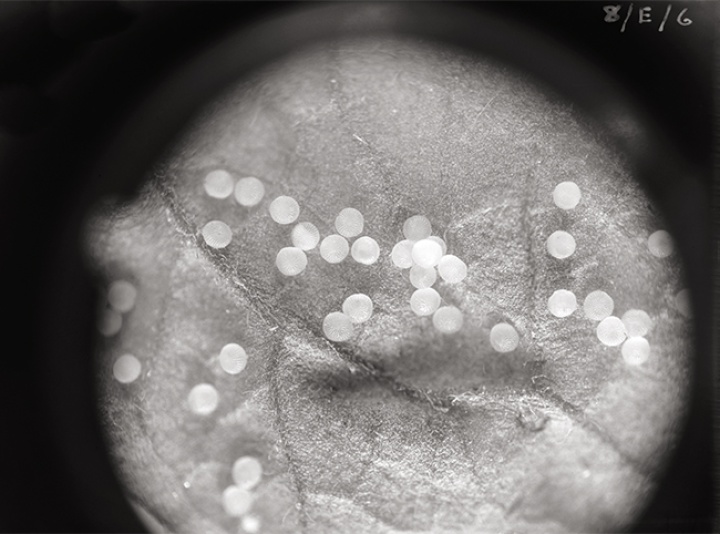Science in the Darkroom
Science in the Darkroom:
Unseen science
on glass plate negatives from the Plant & Food Research
collection
7 January 2019
A chance discovery has brought the delicate lost art of glass plate photography back to life at an exhibition of forgotten images and negatives in Auckland.

Unknown photographer, circa 1950s, gelatin
glass negative half plate
©Plant & Food
Research
The show Science in the Darkroom will run at the historic Alberton house at 100 Mt Albert Rd, from 16 January to 27 January 2019.
The exhibition of 15 highly intricate and beautifully composed photographs will delight photographic enthusiasts as well as those with an interest in the long history of plant research in Mt Albert.
Glass plate photography had once been a go-to technology worldwide from the late-1800s to the mid-1950s before Kodak film and new, smaller cameras transformed photography and made it accessible to everyone. The dry-plate process, also known as the gelatin process, was used to document science subjects by photographers internationally and in New Zealand because of its superior chemical stability and quality compared to film. Glass plates were still being used in high-quality photography as late as the 1980s.
Like all technology, glass plate had its upsides and downsides. Photographers had to master the cumbersome, time-consuming and fickle process, but when everything came together the results were astounding.
“This exhibition brings impressive composition, amazing plant photography and the unique finish of glass plate photography into our contemporary world,” says Wara Bullôt, co-curator of the exhibition and Plant & Food Research photographer.
“I can only admire the skill of the people who worked in this challenging medium and used it so well to capture images that tell compelling stories. Some of these photographers, like Steve Rumsey, were phenomenal at their time. They were highly skilled and had great patience and a deep understanding of their craft.”
The exhibition was prompted by the discovery of a large collection of glass plate negatives in the Hamilton Building at the Plant & Food Research Mt Albert Research Centre in 2018. At that time the six-story building was undergoing a major redevelopment, and staff and equipment had to be relocated. These plates are a treasure trove of the extensive photographic work done by DSIR (Department of Scientific and Industrial Research), the government agency that preceded the Crown Research Institutes of today.
Bullôt came across the glass plate negatives, each wrapped in an individual paper sleeve, and immediately realised their importance. Some of the plates came with a precise hand written label with a short description of the subject, its purpose, location and the date of when the image was taken. A small positive print also accompanied each plate.
The plates were stored in large steel drawers and filed alphabetically, similar to how the in-house image archive works today, except all images are now stored digitally and are tagged with key words to enable rapid searches by staff.
"Working with these glass plates took us back in time. There are plenty of stories to be told. We want to bring these images back to life to embrace and appreciate the traditional photographic process as we are consumed by the fast-paced digital world and phone photography nowadays.”
For more information and a sneak
peek of selected images: www.scienceinthedarkroom.nz
#scienceinthedarkroom
Key
information:
* Science in the Darkroom is shown at
Alberton from 16 to 27 January 2019 (closed on 21 and 22
January 2019), 10.30 a.m. to 4.30 p.m.
* The exhibition
opening night is 16 January 2019, 4:30 p.m. to 7 p.m.
*
The exhibition is in the Alberton Ballroom at 100 Mt Albert
Road, Mt Albert Auckland 1025
* Entry to exhibition is
free. A $10 fee applies to view the entire Alberton
house.


 Greenpeace: Taranaki - Greenpeace Activists Stop Unloading Of Palm Kernel Sourced From Indonesian Rainforests
Greenpeace: Taranaki - Greenpeace Activists Stop Unloading Of Palm Kernel Sourced From Indonesian Rainforests Seafood New Zealand: Seafood Situation Saved By A Sausage - New Plymouth Locals Innovate, Using Crayfish Bait
Seafood New Zealand: Seafood Situation Saved By A Sausage - New Plymouth Locals Innovate, Using Crayfish Bait Takeovers Panel: Takeovers Panel Convenes Meeting To Inquire Into The Acquisition Of Shares In NZME Limited
Takeovers Panel: Takeovers Panel Convenes Meeting To Inquire Into The Acquisition Of Shares In NZME Limited WorkSafe NZ: Conveyor Belt Death-Trap Was A Danger In Plain Sight
WorkSafe NZ: Conveyor Belt Death-Trap Was A Danger In Plain Sight Commerce Commission: 2degrees Fined $325,000 For Misleading Claims About ‘Free’ Aussie Business Roaming
Commerce Commission: 2degrees Fined $325,000 For Misleading Claims About ‘Free’ Aussie Business Roaming  Natural Hazards Commission: Hub Launched To Empower Architects And Engineers To Build Above Code
Natural Hazards Commission: Hub Launched To Empower Architects And Engineers To Build Above Code



